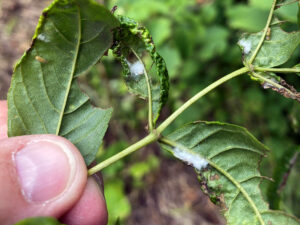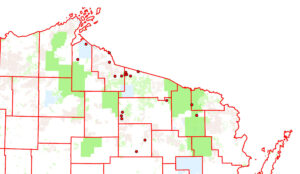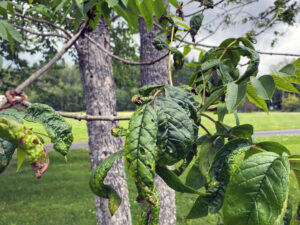
Cottony ash psyllid nymphs feed on the lower sides of leaves and grow white wool over themselves for protection. / Photo Credit: Wisconsin DNR
By Linda Williams, DNR Forest Health Specialist, Woodruff
Linda.Williams@wisconsin.gov, 920-360-0665
Cottony ash psyllid (Psyllopsis discrepans) was observed in 2023 in several areas in northern Wisconsin. Additional sites were then identified in 2024 and this year.
Some provinces in Canada have observed that psyllid numbers can explode during dry periods, so that may be why we started to see some issues in Wisconsin in 2023.
Cottony ash psyllid is a tiny, sap-sucking insect that has been in North America for almost 100 years but was first identified in Wisconsin in 2006. It feeds on black ash (and closely related ash species, such as Manchurian ash). Green and white ash are avoided.

A map showing known cottony ash psyllid infestations in northern Wisconsin. / Graphic Credit: Wisconsin DNR
The insect has two generations per year. The first generation feeds on newly emerged leaves in the spring. Feeding causes those leaves to curl tightly. Trees seems to interpret that as being defoliated and will tap into their energy reserves to send out a second set of leaves. But the second generation of psyllids feed on those second leaves and puts severe stress on the tree when those leaves are heavily damaged.
A close look at the underside of curled leaves will often reveal nymphs, adults or both, depending on the time of year. Nymphs feed on the lower surfaces of the leaves, where they cover themselves with cottony, waxy material. Adults resemble leafhoppers and can jump when disturbed.
Observations in some areas of northern Wisconsin seem to show that cottony ash psyllid is causing a rapid decline of black ash in areas where emerald ash borer is not present to cause that decline.
Control options for cottony ash psyllid are still being evaluated. Preferred control options for emerald ash borer don’t work on cottony ash psyllid. Various studies are underway to identify what will work best.

Feeding by cottony ash psyllid causes leaves to pucker and curl. / Photo Credit: Wisconsin DNR
Unfortunately, by the time damage is noticeable, infested trees may be too stressed or compromised to adequately take up systemic insecticides. Because the nymphs feed on the undersides of the tightly curled leaves, they are somewhat protected from foliar spray application, so it’s important to time sprays for when the adults are out and mating. Treating lowland black ash forests with systemic insecticides is not practical.
